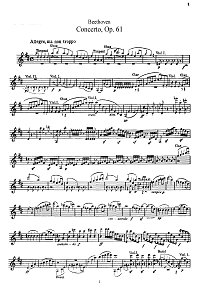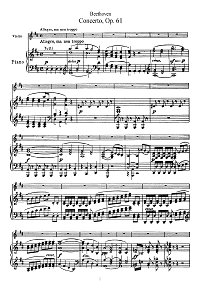Beethoven - Violin concerto D-dur Op.61
Beethoven - Violin concerto D-dur Op.61. You can download the PDF sheet music Beethoven - Violin concerto D-dur Op.61 on this page.
- Allegro ma non troppo
- Larghetto
- Rondo. Allegro
The Concerto in D, Op. 61 was not begun until late in 1806, shortly after he had completed his Fourth Piano Concerto and Fourth Symphony. He wrote it for Franz Clement who was leader and conductor of the orchestra at the Theater an der Wien in Vienna. The concert was evidently a considerable success as far as Clement was concerned, but Beethoven did not escape unscathed. The concerto was overshadowed until as late as the 1840's, when the young Joachim restored it to its rightful position in the violinist's repertoire.
To download PDF, click the "Download PDF" button below the appropriate sheet music image.
To view the first page of Beethoven - Violin concerto D-dur Op.61 click the music sheet image.
|
| PDF format sheet music |
|
|
|
Instrument part: 21 pages. 1834 K
|
Piano part: 41 pages. 3437 K
|
 |
 |
|
|
| Download PDF (14.99
€) |
Download PDF (14.99
€) |
|
The bravura element is conspicuously absent from the first movement, which is dominated by the four soft drum beats of the very opening bar. They are an essential part of the first subject, a gentle, curving tune played by oboes, clarinets, and bassoons; their influence can be felt in the second subject (which is very similar in outline) and they permeate the dark-hued development section. The soloist enters with a short cadenza in tempo, and a similar passage introduces the development, the first part of which is devoted to the first two bars of the first subject, against which the violin plays a counterpoint in triplet arpeggios; the second part introduces a hauntingly beautiful new theme in G minor, high up on the violin, from which a short semiquaver figure is retained and developed by the soloist, until it is formed into a link with the recapitulation. Underlying the whole passage, with its sombre orchestral coloring of strings reinforced by bassoons, horns, trumpets, and drums, in turn, is the pervasive four-beat figure of the opening. After the recapitulation the order of events corresponds to that of the exposition, but with the violin taking an active part from the start.
It seems likely that Beethoven may have used his two earlier Romances for violin and orchestra as models for the slow movement of the concerto. This G major Larghetto, in which the wind section is reduced to clarinets, bassoons, and horns, and in which the orchestral violins are muted except in the final bars, is a series of variations on a theme which is stated at the outset by the strings, and which the solo violin embellishes with the most exquisite tracery of arabesques but never actually appropriates - though it does introduce a new theme of its own in a brief episode between third and fourth variations. A powerful summons on the orchestral strings, now senza sordini, prepares the ground for the last movement, which follows without a break. This is a sonata-rondo whose refrain is surely one of the happiest tunes ever written. The brilliant first and third episodes contain the concerto's nearest approach to virtuoso writing, and they are thrown into relief by the restraint of the second episode, which introduces another eloquent theme in G minor, again in the violin's higher register. The violinist is given an opportunity to insert a cadenza towards the end of the movement, but the solo part continues after it until the very last bar of the concerto. |
|